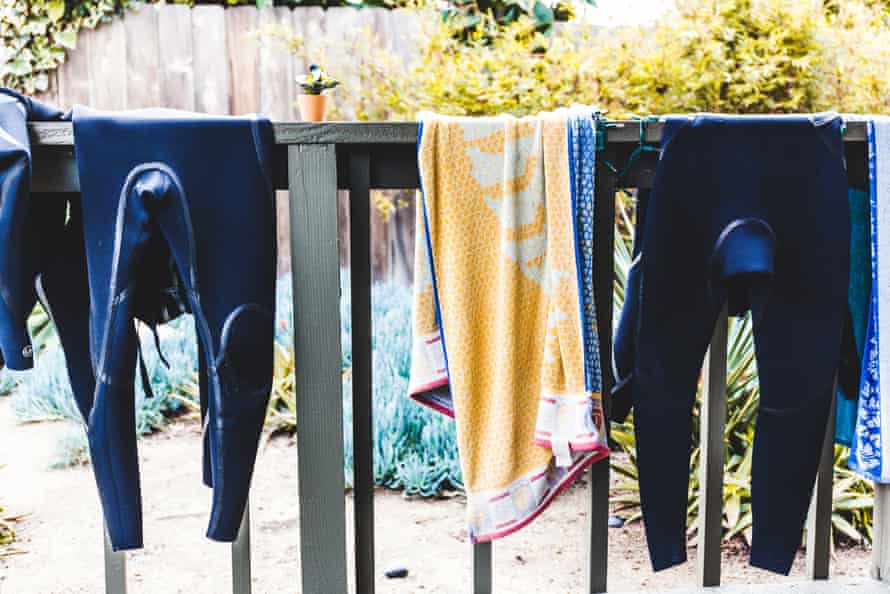
The late editor Diana Vreeland announced she was envious of surfers during a television interview in the 1970s. “To be a surfer” she said, “between the sky and the water would be, to me, the most wonderful thing”.
It’s a sentiment I share, despite finding surfing cold, hard and kind of tedious. The first time I tried it, I mistook a dolphin for a shark and my enthusiasm for it never really recovered. But (like Vreeland) I love the water, and anything that allows me to spend more time in it – like wetsuits. Treated correctly, a good one can last for a decade or more. This week, experts share their advice for protecting the garments that protect you.
Suiting up
Lesley Hillyer, owner of Aquasea Underwater Products, sees a lot of broken zips. She says people will often put their wetsuit “halfway on and expect the zipper to finish the job”. She points out that zippers are made of plastic, and cannot handle this kind of repeated strain. While it’s easy enough to repair a broken zip, a bit of extra care slipping into a wetsuit can save you time and money.
She advises putting a plastic bag over your foot before you step into each wetsuit leg, as this will make it easier to pull on. If your suit has especially narrow ankles and you’re finding it difficult to take on and off, she suggests getting a professional to cut a wave pattern along the ankle opening, which will increase the surface area and make it easier to take on and off.
Post-surf care

After spending hours in the water, getting out of a wetsuit feels pretty good. But no matter how desperate you are to get warm and dry, be mindful of where you’re standing when you go to strip off.
Hub Hubbard, a wetsuit product developer at Patagonia cautions against undressing on hard or rough surfaces. He suggests laying down a towel or standing in a large bucket to prevent anything abrasive from damaging your suit.
Then be sure to rinse your wetsuit thoroughly with fresh water, inside and out. It’s really important to get all the salt out because it can damage your suit over time and, in the short term, a salty suit will take longer to dry.
Hillyer says standing under the shower to rinse your suit is not sufficient to remove the salt. Instead, you should submerge it in a tub of water and slosh it around.
Washing and drying
Every so often, your wetsuit should be washed with a mild non-detergent soap, Hubbard says. Be sure to do this by hand and not in the washing machine, as the machine’s agitator can cause damage.
Similarly, putting a wetsuit in a tumble dryer can weaken the fibres. Instead, dry your suit by hanging it in the shade out of direct sunlight, as sun ages neoprene.

When you hang your suit, do so by the waist. Hillyer sees a lot of damage in the shoulders of wetsuits that have been hung on coat hangers to dry. She says this is because when the suits are wet, they are very heavy and this puts stress on the shoulders.
Instead, she suggests purchasing a piece of plastic pipe from a hardware store, cutting a slit along the length of it and sliding it over your washing line. Then you can fold your wetsuit over the pipe, by the waist. When one side is dry, flip it over, so you get an even dry on both sides.
If it’s raining and you need to hang the suit inside, make sure it is in a well-ventilated area to avoid mould. Hubbard says, “I keep all of mine in the garage on a hanger”.
Shopping tips
When shopping for a wetsuit it’s important to look for one that will function well for your age and build. Hillyer says suits with chest zips are “fantastic if you’re a 16-year-old boy with no shoulders, but if you’re older and less flexible, the chances of breaking the zip as you put the suit on are much higher.”
If you’re trying on a suit with a back zip, make sure it is long enough in the body. If the neck of your suit feels like it’s choking you, that is because the suit is too short in back, she says. Equally, it is important your knee is sitting in the middle of the suit’s kneecap. Otherwise, your knee will put pressure on the seams above or below it, and can cause the suit to tear.
Repairing your wetsuit
If your wetsuit tears or the zip breaks, Hubbard says to get it repaired promptly so the damage doesn’t get worse.
This is particularly important if a seam unravels, Hillyer says, because “the only thing holding your suit together is glue line and the seam”.
If you notice a loose thread, knot it off and take it to get it fixed. “If you wait too long, the glue line will give up and your suit will tear”.



